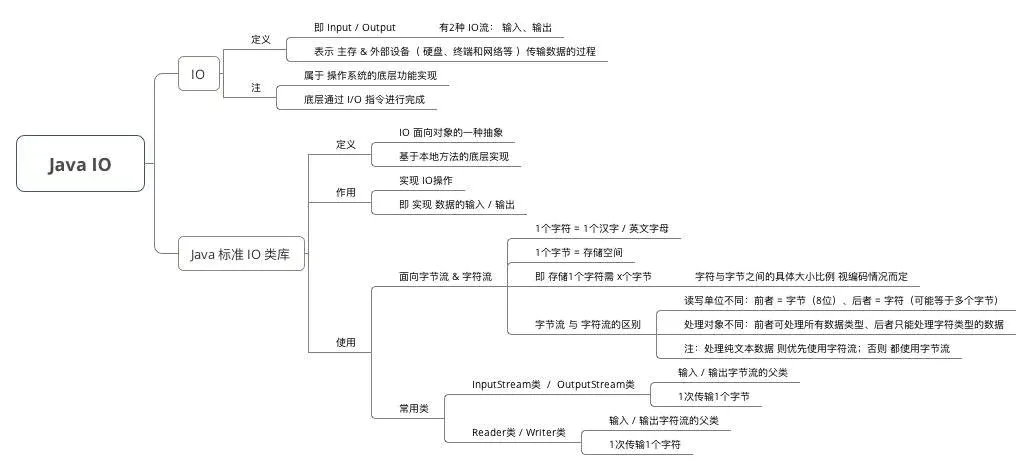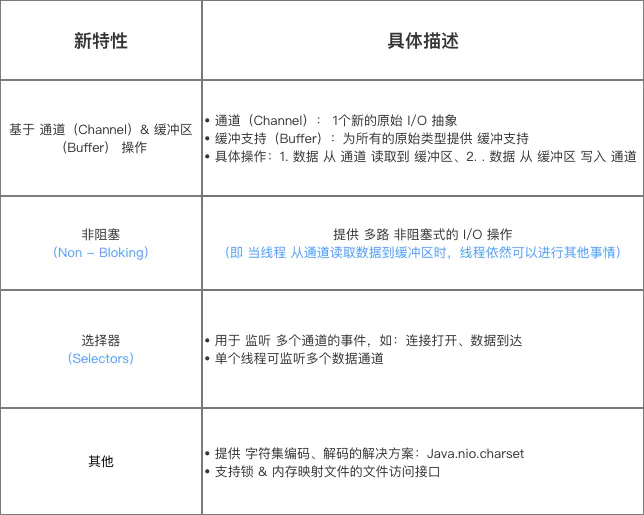前言:
java.nio全称java non-blocking IO(实际上是 new io),是指JDK 1.4 及以上版本里提供的新api(New IO) ,为所有的原始类型(boolean类型除外)提供缓存支持的数据容器,使用它可以提供非阻塞式的高伸缩性网络。本文主要全面 & 详细解析Java New IO,希望对于学习NIO能有帮助~
Java IO

新特性
对比于 Java IO,NIO具备的新特性如下

核心组件
Java NIO的核心组件 包括:
- 通道(
Channel) - 缓冲区(
Buffer) - 选择器(
Selectors)

具体使用
基于通道 & 缓冲数据
具体步骤如下:
// 1. 获取数据源 和 目标传输地的输入输出流(此处以数据源 = 文件为例)
FileInputStream fin = new FileInputStream(infile);
FileOutputStream fout = new FileOutputStream(outfile);
// 2. 获取数据源的输入输出通道
FileChannel fcin = fin.getChannel();
FileChannel fcout = fout.getChannel();
// 3. 创建 缓冲区 对象:Buffer(共有2种方法)
// 方法1:使用allocate()静态方法
ByteBuffer buff = ByteBuffer.allocate(256);
// 上述方法创建1个容量为256字节的ByteBuffer
// 注:若发现创建的缓冲区容量太小,则重新创建一个大小合适的缓冲区
// 方法2:通过包装一个已有的数组来创建
// 注:通过包装的方法创建的缓冲区保留了被包装数组内保存的数据
ByteBuffer buff = ByteBuffer.wrap(byteArray);
// 额外:若需将1个字符串存入ByteBuffer,则如下
String sendString="你好,服务器. ";
ByteBuffer sendBuff = ByteBuffer.wrap(sendString.getBytes("UTF-16"));
// 4. 从通道读取数据 & 写入到缓冲区
// 注:若 以读取到该通道数据的末尾,则返回-1
fcin.read(buff);
// 5. 传出数据准备:将缓存区的写模式 转换->> 读模式
buff.flip();
// 6. 从 Buffer 中读取数据 & 传出数据到通道
fcout.write(buff);
// 7. 重置缓冲区
// 目的:重用现在的缓冲区,即 不必为了每次读写都创建新的缓冲区,在再次读取之前要重置缓冲区
// 注:不会改变缓冲区的数据,只是重置缓冲区的主要索引值
buff.clear();基于选择器(Selecter)
具体Server代码如下:
public class Server implements Runnable{
private Selector selector; //多路复用器
private ByteBuffer readBuf = ByteBuffer.allocate(1024); //缓冲区
public Server(int port){ //构造函数
try {
//1、打开多路复用器
this.selector = Selector.open();
//2、打开服务器通道
ServerSocketChannel ssc = ServerSocketChannel.open();
//3、服务器通道记得设置为feizuse
ssc.configureBlocking(false);
//4、服务器通道绑定地址
SocketAddress local = new InetSocketAddress(port);
ssc.bind(local);
//5、将服务器通道注册到多路复用器那,并且监听阻塞事件
ssc.register(this.selector, SelectionKey.OP_ACCEPT);
System.out.println("服务器已经启动,端口号为:"+port);
} catch (IOException e) {
e.printStackTrace();
}
}
@Override
public void run() {
while(true){ //一直循环,让多路复用器一直监听
try {
//1、让多路复用器开始监听(必须的)
this.selector.select();
//2、返回多路复用器已经选择的结果集
Set<SelectionKey> keys= this.selector.selectedKeys();
//3、遍历结果集,进行处理
Iterator<SelectionKey> ite = keys.iterator();
while(ite.hasNext()){
SelectionKey key = ite.next();
//获取后直接从容器中移出就可以了
ite.remove();
if(key.isValid()){//如果key是有效的
if(key.isAcceptable()){ //如果key为阻塞状态(这个和注册的时候绑定的状态对应)
this.accept(key);
}
if(key.isReadable()){ //如果是可读状态
this.read(key);
}
}
}
} catch (IOException e) {
e.printStackTrace();
}
}
}
private void accept(SelectionKey key) {
try {
// 先获取服务器通道
ServerSocketChannel ssc = (ServerSocketChannel) key.channel();
//调用服务器端的accpet方法获取客户端通道
SocketChannel sc = ssc.accept();
//设置为非阻塞
sc.configureBlocking(false);
//将客户端通道注册到多路复用器中
sc.register(this.selector,SelectionKey.OP_READ);
} catch (IOException e) {
e.printStackTrace();
}
}
/**
* 这个方法是读取客户端发送给服务端的数据的。因为客户端通道注册时的注册状态为read
* @param key
*/
private void read(SelectionKey key) {
try {
//1、先清空缓冲区,防止有上一次的读数据
this.readBuf.clear();
//2、获取客户端通道
SocketChannel sc = (SocketChannel) key.channel();
//3、看客户端是否有输入
int count = sc.read(this.readBuf);
if(count == -1){//如果没有数据
sc.close();
key.cancel();
}
//4、如果有数据则进行读取,读取之前记得要进行缓冲区复位。
this.readBuf.flip();
//5、根据缓冲区的数据长度创建对应大小的byte数组,接受缓冲区的数据
byte[] data = new byte[this.readBuf.remaining()];
//6、将缓冲区数据弄到byte数组里面
this.readBuf.get(data);
//7、将byte数组转为字符串打印出来
String result = new String(data);
System.out.println("Server接受到client的数据:"+result);
} catch (IOException e) {
e.printStackTrace();
}
}
public static void main(String[] args) {
//开启一个线程,保证多路复用器一直在轮询
new Thread(new Server(8765)).start();
}
}具体Client代码如下:
public class Client {
public static void main(String[] args){
try {
//1、创建以一个客户端通道
SocketChannel sc = SocketChannel.open();
//这里是服务器端的IP地址和端口号
InetSocketAddress add = new InetSocketAddress("127.0.0.1", 8765);
//客户端通道连接服务器端通道
sc.connect(add);
//定义缓冲区,拿来接收用户的输入
ByteBuffer buf = ByteBuffer.allocate(1204);
while(true){ //死循环,用户可以无限输入
//定义一个字节数组,然后使用系统的输入功能
byte[] bytes = new byte[1024];
System.in.read(bytes);
//将数据放入缓冲区
buf.put(bytes);
//记得进行复位操作
buf.flip();
//写出数据
sc.write(buf);
//清空缓冲区
buf.clear();
}
} catch (IOException e) {
// TODO Auto-generated catch block
e.printStackTrace();
}
}
}
实例解析
- 实例说明:实现文件复制功能
- 实现方式:通道
FileChannel、 缓冲区ByteBuffer
import java.io.FileInputStream;
import java.io.FileOutputStream;
import java.io.IOException;
import java.nio.ByteBuffer;
import java.nio.channels.FileChannel;
public class Test {
public static void main(String[] args) throws IOException {
// 设置输入源 & 输出地 = 文件
String infile = "C:\\old.txt";
String outfile = "C:\\copy.txt";
// 1. 获取数据源 和 目标传输地的输入输出流(此处以数据源 = 文件为例)
FileInputStream fin = new FileInputStream(infile);
FileOutputStream fout = new FileOutputStream(outfile);
// 2. 获取数据源的输入输出通道
FileChannel fcin = fin.getChannel();
FileChannel fcout = fout.getChannel();
// 3. 创建缓冲区对象
ByteBuffer buff = ByteBuffer.allocate(1024);
//4.将通道的数据存入缓冲区
while (fcin.read(buff)!=-1){
//缓冲区切换为读模式
buff.flip();
//5.将缓冲区数据写入通道
fcout.write(buff);
buffer.clear();
}
fcin.close();
fcout.close();
fin.close();
fout.close();
}
}与JAVA IO的区别




